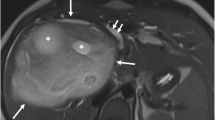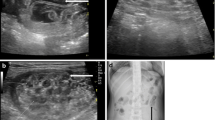Abstract
Parasitic diseases of the liver and biliary tract include echinococcosis, schistosomiasis, toxocariasis, clonorchiasis, and opisthorchiasis, affecting millions people in some endemic areas. Amebiasis and ascariasis are believed to be the most common bowel lumen indwelling parasitic diseases, affecting billions people worldwide, but sometimes these parasites migrate inadvertently to the liver and biliary tract, resulting in liver abscess or obstructive jaundice. Imaging findings of these parasitic diseases are fairly characteristic and easy to recognize if radiologists are aware of the findings, especially in endemic areas. Because of increased immigration and frequent travelling, some patients with “exotic” parasitic diseases may be encountered in non-endemic areas, and the diagnosis may be delayed or difficult, and it is often made only after operation. This feature section was designed to provide the detailed imaging features of common parasitic diseases affecting the abdominal organs and peritoneal cavity, based on pathology-image correlation.
Similar content being viewed by others
Avoid common mistakes on your manuscript.
Parasitic diseases are usually endemic. Some are common in certain endemic areas while others are prevalent in others. Some parasitic diseases have been controlled in certain parts because of improvement in hygiene, but many are still prevailing because of poverty and pollution. The incidence of some foodborne parasitic diseases has been increased because of increased production of raw food [1]. Approximately billions of people in the world are infected with some kinds of parasites. When we check global distribution of all kinds of parasitic diseases in a world map, the whole world is an endemic area with different parasitic diseases being prevalent in different areas. Indeed, parasitosis and helminthiasis are the most common disease in the world and thus take an enormous toll on human health and the life quality in societies throughout the world [1, 2].
Many patients with parasitic diseases are asymptomatic and the diseases resolve spontaneously. Even if parasites persist for a long time in the human body, they do not usually provoke strong host reaction. In fact, many patients with parasitic diseases are doing well. Patients with heavy infection or patients in the initial infective stage may have symptoms. Symptoms of some parasitic diseases are characteristic, but patients with abdominal parasitosis have non-specific symptoms or only constitutional symptoms. Therefore, making the diagnosis may be difficult and confusing when a physician is not aware of the possibility of parasitic disease.
More often than not, parasites degenerate and die in human tissues. On the other hand, some parasites live for a long time in the human body, from several years to decades, and they produce chronic inflammation. Furthermore, many patients have repeated and cumulative infections. Because of persistent or life long exposure to parasites and their excreta, cancer may develop. For example, hepatocellular carcinoma or bladder cancer develops in patient with schistosomiasis [3–5] and cholangiocarcinoma develops in patients with clonorchiasis or opisthorchiasis [5–8]. Indeed, cholangiocarcinoma is by far the most common cancer in some endemic areas where opisthorchiasis is prevalent [1, 9, 10].
Making the diagnosis is usually easy in endemic areas. Direct demonstration of parasites or their eggs in the feces, urine, body fluid, blood, or tissue is diagnostic. Serologic tests, most importantly, the enzyme-linked immunoabsorbent assay is another reliable test. Many patients have eosinophilia in the peripheral blood and this is an important clue leading to the diagnosis of parasitic infection [11]. Once diagnosed, the treatment is usually simple: administration of antihelminthics will eradicate parasites. However, in the non-endemic areas, diagnosis can be difficult and biopsy or surgery is necessary to establish a diagnosis. Because of delayed diagnosis of persistent eosinophilia, some patients end up undergoing anticancer chemotherapy.
With the recent advance in imaging technology and serologic testings, it is possible to make a diagnosis of most parasitic disease accurately and non-invasively. The imaging findings of some parasitic diseases are fairly characteristic. When a radiologist is aware of typical imaging findings, then making the diagnosis is simple and easy. However, in non-endemic areas where a certain parasitic disease is not often encountered, parasitic disease is not often considered in the differential diagnosis. Because of increased immigration and frequent traveling, some patients with “exotic” parasitic diseases may be encountered in non-endemic areas and the diagnosis may be delayed or difficult, and it is made only after an operation.
The Feature Section in this issue of Abdominal Imaging was designed to provide the detailed imaging features of common parasitic infection in the abdominal cavity, specifically in the liver, biliary tract, gastrointestinal tract, and in the peritoneal cavity. Some parasitic diseases affecting the lungs and urinary bladder will be covered in the appropriate sections of individual parasitosis.
Because different parasitic diseases are encountered in different parts of the world, several scholars from different places in which the particular parasitic infection is prevalent have been invited to contribute to this Feature Section. Echinococcosis caused by Echinococcus granulosus is prevalent in the Middle East, the Mediterranean countries, Africa and South America, and Dr. Okan Akhan of Ankara, Turkey describes the imaging characteristics of hepatic infection. Echinococcosis caused by Echinococcus multilocularis is found in sub-Arctic or the Arctic regions of North America, Europe and Asia, and the imaging findings of this infection are described by Dr. Benedikt V. Czermak and colleagues of Innsbruck, Austria.
Schistosomiasis caused by Schistosoma mansoni is found in parts of South America, some Caribbean islands, Africa and the Middle East, and Dr. Adonis Manzella of Recife, Brazil describes detailed imaging findings concerning intestinal and hepatosplenic schistosomiasis. Schistosomiasis caused by Schistosoma japonicum occurs in East Asia and Dr. Kuni Ohtomo of Tokyo, Japan and Dr. Shuichi Monzawa of Hyogo, Japan describe the imaging characteristics of schistosomiasis caused by S. japonicum.
Toxocariasis caused by larvae of the dog ascarid, Toxocara canis, has worldwide distribution and these cases have been reported sporadically and mainly in children. The real incidence is not known, probably because only a minority of patients has clinical problems. Toxocariasis is being recently reported in adults among some ethnic groups of people who have a habit of eating uncooked animal tissue [11, 12]. Dr. Jae Hoon Lim of Seoul, South Korea describes the imaging findings of hepatic visceral larva migrans of T. canis.
Biliary parasites or liver flukes include Clonorchis sinensis and Opisthorchis viverrini, and they are found in East Asia and Southeast Asia, respectively. There are millions of people infected, especially at regions along some rivers, because of the habit of eating raw fresh water fish, and there are many patients with intrahepatic and extrahepatic cholangiocarcinoma as a late complication of the disease. Fascioliasis caused by Fasciola hepatica involves both the liver and bile ducts and it occurs worldwide in areas where sheep and cattle are raised. Dr. Jae Hoon Lim of Seoul, South Korea, and Dr. Eimorn Mairiang of Khon Kaen, Thailand, describe the imaging findings of biliary parasitic infections.
Intestinal parasitic diseases such as amebiasis, ascariasis, giardiasis, strongyloidiasis, ancylostomiasis, trichuriasis, anisakiasis, and tapeworm disease have no specific endemic areas and they are distributed worldwide. Dr. Mi-Sook Park and colleagues of Seoul, South Korea describes the imaging findings of intestinal parasitic diseases, and particularly those of amebiasis, ascariasis, and anisakiasis. Some parasites reach to the peritoneal space during their migratory life cycle and they inadvertently reside there and produce inflammatory reaction. These include paragonimiasis, sparganosis, echinococcosis, etc. The image findings of these “ectopic” infections are described by Dr. So Yeon Kim and Dr. Hyun Kwon Ha of Seoul, South Korea.
In each section, the authors delineate the definition, epidemiology and brief life cycle of parasites, and the pathophysiology, clinical findings, complications, and detailed imaging findings. Pathologic-imaging correlation is discussed based on the pathologic specimens of natural infection or on specimens from animal experiments.
We sincerely hope that this Feature Section concerning abdominal parasitic diseases will help readers better understand the imaging features based on the gross findings of parasites found in the sections of human and animal tissues and the resultant pathologic alteration. Those radiologists who work in endemic areas should have thorough and comprehensive understanding of the relevant imaging findings, and those who work in non-endemic areas should be familiar with the typical findings of parasitic diseases of the abdomen lest parasitic diseases are mistaken for other diseases such as malignant tumors.
References
WHO Study Group on the Control of Foodborne Trematode Infection (1995) Control of foodborne trematode infections. WHO Technical Report Series 849, pp 1–7, 58–65
Orihel TC, Ash LR (1995) Parasites in human tissues, 1st ed. Hong Kong: American Society of Clinical Pathologists Press, p xi
Yosry A (2006) Schistosomiasis and neoplasia. Contrib Microbiol 13:81–100
Ishii A, Matsuoka H, Aji T et al (1994) Parasite infection and cancer: with special emphasis on Schistosoma japonicum infections (Trematoda). A review. Mutat Res 305:273–281
Abdel-Rahim AY (2001) Parasitic infections and hepatic neoplasia. Dig Dis 19:288–291
Choi D, Lim JH, Lee KT et al (2006) Cholangiocarcinoma and Clonorchis sinensis infection: a case-control study in Korea. J Hepatol 44:1066–1073
Choi BI, Han JK, Hong ST et al (2004) Clonorchiasis and cholangiocarcinoma: etiologic relationship and imaging diagnosis. Clin Microbiol Rev 17:540–552
Watanapa P, Watanapa WB (2002) Liver fluke-associated cholangiocarcinoma. Br J Surg 89:962–970
Haswell-Elkins MR, Mairiang E, Mairiang P et al (1994) Cross-sectional study of Opisthorchis viverrini infection and cholangiocarcinoma in communities within a high-risk area in northeast Thailand. Int J Cancer 59:505–509
Elkins DB, Haswell-Elkins MR, Mairiang E et al (1990) A high frequency of hepatobiliary disease and suspected cholangiocarcinoma associated with heavy Opisthorchis verrini infection in a small community in north-east Thailand. Trans R Soc Trop Med Hyg 84:715–719
Kwon N-H, Oh M-J, Lee S-P et al (2006) The prevalence and diagnostic value of toxocariasis in unkown eosinophilia. Ann Hematol 85:233–238
Chang S, Lim JH, Choi D et al (2006) Hepatic visceral larva migrans of Toxocara canis: CT and sonographic findings. AJR Am J Roentgenol 187:W622–W629
Author information
Authors and Affiliations
Corresponding author
Rights and permissions
About this article
Cite this article
Lim, J.H. Parasitic diseases in the abdomen: imaging findings. Abdom Imaging 33, 130–132 (2008). https://doi.org/10.1007/s00261-007-9323-0
Published:
Issue Date:
DOI: https://doi.org/10.1007/s00261-007-9323-0




